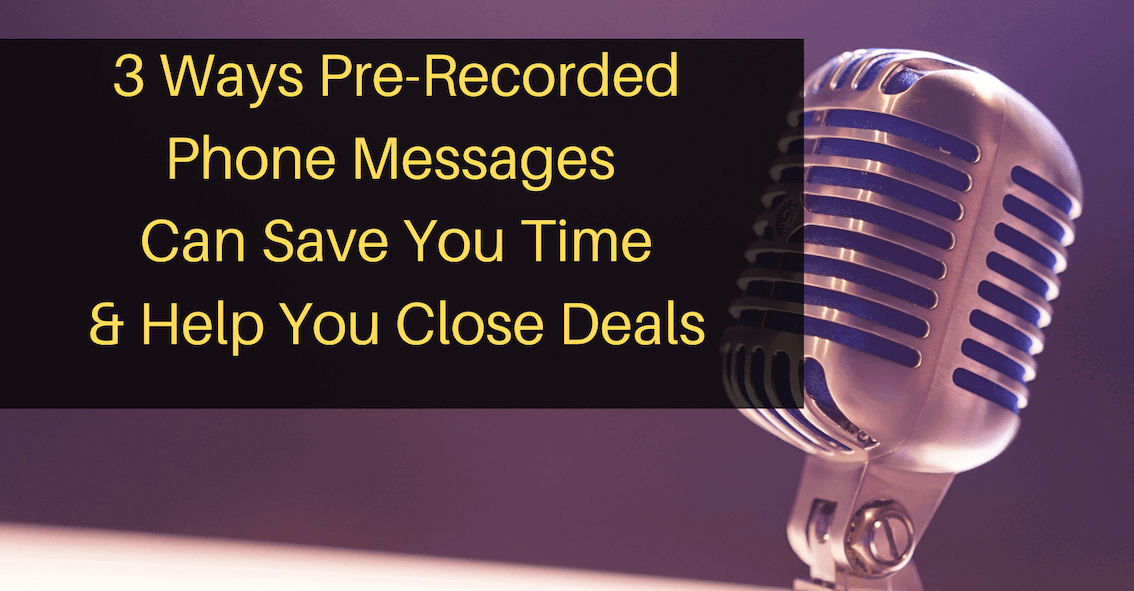You’ve got enough to do! Give yourself a break with pre-recorded phone messages so you can give more attention to other aspects of your sales strategy.
There was a time when phone sales reps had to spend literally hours leaving voicemail after voicemail in the hopes of eliciting a call-back leading to a sale. And while the efforts weren’t entirely unrewarded, the results could often be disappointing at best. That’s why so many phone salespeople are praising the advent of pre-recorded phone messages.
Telephone sales has always been a tricky business, and even more so with caller ID readily available on most mobile phones. Many people won’t pick up the phone if they don’t recognize the number, making voicemail all the more critical in opening a dialogue with customers or potential customers. Pre-recorded phone messages, or “voicemail drop,” allow sales agents to leave a detailed and engaging message with just the push of a button. No more repeating the same message dozens of times a day or fumbling for the right words. When a call goes to voicemail, all an agent has to do is click once (in most cases), and your software will leave a voicemail while the agent is already on to their next call.
Still not convinced?
Improve productivity and overall results with Call Logic’s cloud-based auto-dialer CRM. Schedule a free demo today to learn about features like voicemail drop, whisper coaching, real-time scrubbing, and more!
Here are three ways that pre-recorded phone messages can help increase effectiveness and productivity for a salesperson.
1. Make time for more calls
Perhaps the most apparent advantage of pre-recorded phone messages is that they save a salesperson time. Let’s say an average salesperson leaves fifty voicemails per day—not unlikely given that some 80% of sales calls go to voicemail. If the average voicemail takes 2.5 minutes to leave, from listening to the outgoing message to recording the incoming message, that’s 125 minutes per day a single sales rep spends on leaving voicemails. If you have 25 people in your call center, that’s 3,125 minutes per day allotted to leaving messages that may never be returned. (In case you’re counting, that’s just over 52 hours each day!)
With pre-recorded phone messages, you can reduce that time by more than half. Many phone sales automation systems make it possible to leave a useful message with the click of a single button, so instead of 2.5 minutes per voicemail, you’re talking about mere seconds. The pre-recorded message is left while the sales rep is already onto their next call. Just imagine what your sales team could do with 125 extra minutes per agent, per day!
2. Standardize messages
Unless you used a voicemail script, every time you left a message, you had to remember all the key points to touch on in each voicemail. After dozens of calls a day, some of those points likely slipped through the cracks, potentially costing you customers.
With pre-recorded phone messages, you only need a few scripts, and even better, you only need to record your messages once. This allows for standardization of your calls, ensuring that you touch on only the most essential things in your voicemails. You’ll also find it easier to stay on topic, to keep your messages brief while still informative, and to make sure that you’re using an upbeat, consistent tone throughout your message.
3. Measure success
A third useful feature of pre-recorded phone messages is that you can use the data collected in your CRM to determine which messages get the most traction. Start with two or three different variations for different customers and after a week, see if any of them were more effective than others. It may take a few weeks or even a month of research to see what’s working and what isn’t, but once you find the sweet spot, you can start using that message with more customers, hopefully resulting in more closed sales.
Keep in mind, however, that depending on what you’re selling and who the clients are, measuring success will likely be an ongoing process. What works today may not be relevant in six months, or a successful message may not fit with specific leads or customers. So even though voicemail automation will save you plenty of time in the long run, it’s not something you do once and forget about.
Bonus tips for recording your messages
While these three benefits of pre-recorded phone messages make voicemail automation enticing, it’s important to remember that not all messages are created equal. To reap these benefits, you’ll need to leave messages that get the job done.
To start with, your pre-recorded messages should be concise. In general, you only have a few seconds to get a customer’s attention with voicemail. That may not seem like a lot of time, but it’s a pretty significant chunk if you make the best use of it.
To do that, we recommend writing out a script for your pre-recorded phone messages so you can time yourself before testing things out on real customers. A script will also help you ensure that you’re including the essential information and not leaving anything out.
Remember to speak more slowly than may feel natural. Again, practice this with a script before going into the field. Find a pace that sounds genuine, but that also allows you to get your full message across.
Finally, don’t forget to pay attention to your tone. Some research indicates that tone accounts for more than 80% of the communication—significantly more than the actual words used. So while word choice is important, tone may be even more so. This is another benefit of pre-recorded phone messages—you can re-record your messages until the tone is right, then never have to worry about it when your team leaves a message for a customer. Cheerfulness, authenticity, and warmth in your voice will all help steer you towards more returned calls, and if all goes well, more closed deals and, of course, more happy customers.
Keep track of your leads and more with Call Logic’s cloud-based auto-dialer software. Sign up for a free demo to find out how you can be more successful today!

